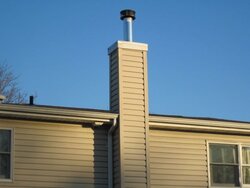My setup has a Class A T- connection and a 90 degree stove pipe elbow. After taking a closer look at the impact this has on my draft, I learned (with the help of another Hearth.com member) that my overall chimney height probably is not quite enough. I always thought there was something wrong because, despite dry wood and a lot of attention to other details, I never seem to avoid some small amount of smoke rolling out of the stove when the door is opened (even slowly and even when the door is open for a period of time). I also never seem to see the stove temperatures expected under ideal conditions. My glass door also tends to get dirty easily and people tell me that Jotul stoves really need optimal draft conditions to avoid problems.
The photo shows my chimney which has an overall height from ground level (also just above sea level where I live) of 22 feet. If this was a straight pipe, that would be more than fine. However, when you figure in the loss of effective chimney height caused by the pipe turns and the 2.5 feet above ground level the stove pipe connects to my stove, I have about 11.5 (effective) chimney height which isn't enough for proper draft.
Anyway... my question is whether or not I need to add an exterior support to the pipe if I add a 4 ft section to what I have. My chimney chase (enclosure) extends above the roof line and the pipe presently extends about 2 feet beyond that. An additional section will be a total of 6 feet above the top of the chase. I am not sure where the highest support bracket is inside the chase, but it mounts to the side of the house somewhere within the chase. I imagine that the stainless cover on the chase acts as the highest support point. BTW, I can't effectively extend any supports to the roof because the pitch is ahallow and it would really be a long run to the roof.
Any opinions or advice would be appreciated.
Thanks
Art
The photo shows my chimney which has an overall height from ground level (also just above sea level where I live) of 22 feet. If this was a straight pipe, that would be more than fine. However, when you figure in the loss of effective chimney height caused by the pipe turns and the 2.5 feet above ground level the stove pipe connects to my stove, I have about 11.5 (effective) chimney height which isn't enough for proper draft.
Anyway... my question is whether or not I need to add an exterior support to the pipe if I add a 4 ft section to what I have. My chimney chase (enclosure) extends above the roof line and the pipe presently extends about 2 feet beyond that. An additional section will be a total of 6 feet above the top of the chase. I am not sure where the highest support bracket is inside the chase, but it mounts to the side of the house somewhere within the chase. I imagine that the stainless cover on the chase acts as the highest support point. BTW, I can't effectively extend any supports to the roof because the pitch is ahallow and it would really be a long run to the roof.
Any opinions or advice would be appreciated.
Thanks
Art


